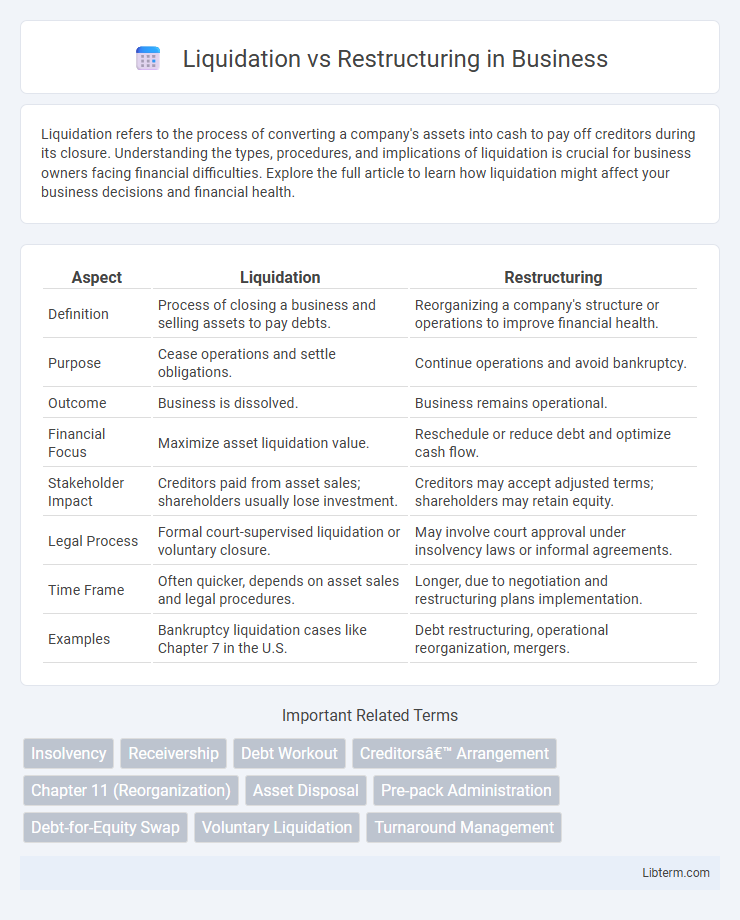Liquidation refers to the process of converting a company's assets into cash to pay off creditors during its closure. Understanding the types, procedures, and implications of liquidation is crucial for business owners facing financial difficulties. Explore the full article to learn how liquidation might affect your business decisions and financial health.
Table of Comparison
| Aspect | Liquidation | Restructuring |
|---|---|---|
| Definition | Process of closing a business and selling assets to pay debts. | Reorganizing a company's structure or operations to improve financial health. |
| Purpose | Cease operations and settle obligations. | Continue operations and avoid bankruptcy. |
| Outcome | Business is dissolved. | Business remains operational. |
| Financial Focus | Maximize asset liquidation value. | Reschedule or reduce debt and optimize cash flow. |
| Stakeholder Impact | Creditors paid from asset sales; shareholders usually lose investment. | Creditors may accept adjusted terms; shareholders may retain equity. |
| Legal Process | Formal court-supervised liquidation or voluntary closure. | May involve court approval under insolvency laws or informal agreements. |
| Time Frame | Often quicker, depends on asset sales and legal procedures. | Longer, due to negotiation and restructuring plans implementation. |
| Examples | Bankruptcy liquidation cases like Chapter 7 in the U.S. | Debt restructuring, operational reorganization, mergers. |
Introduction to Liquidation and Restructuring
Liquidation involves selling a company's assets to pay off creditors and ultimately dissolving the business, often used when the company is insolvent or unable to meet its financial obligations. Restructuring refers to reorganizing a company's operations, debts, or ownership to improve financial stability and maintain ongoing business activities. Both processes aim to address financial distress, with liquidation ending the business and restructuring seeking to preserve its value and future viability.
Defining Liquidation
Liquidation refers to the process of winding up a company's operations by selling off assets to pay creditors before dissolving the business entity. It typically occurs when a company is insolvent and unable to meet its financial obligations, leading to the cessation of its activities. Unlike restructuring, which aims to reorganize and preserve the company's value, liquidation is focused on converting assets into cash and distributing proceeds to stakeholders.
Understanding Restructuring
Restructuring involves reorganizing a company's operations, finances, or structure to improve efficiency and financial stability without ceasing business activities. It often includes debt renegotiation, asset optimization, and operational changes aimed at restoring profitability and maintaining stakeholder value. Understanding restructuring is crucial for identifying viable alternatives to liquidation and preserving enterprise viability in distress situations.
Key Differences Between Liquidation and Restructuring
Liquidation involves selling a company's assets to pay off creditors and ceasing operations permanently, while restructuring aims to reorganize a company's debts and operations to restore profitability and continue business. Liquidation is typically a final process indicating insolvency, whereas restructuring is a strategic effort to avoid bankruptcy and improve financial health. Key differences include the intent to terminate versus recover, asset distribution in liquidation versus operational overhaul in restructuring, and creditor involvement focused on asset claims versus debt renegotiation.
Legal Frameworks and Requirements
Liquidation involves the formal process of dissolving a company under insolvency laws, requiring compliance with statutory provisions such as filing petitions with courts, appointing liquidators, and prioritizing creditor claims according to the Insolvency and Bankruptcy Code or equivalent regulations in various jurisdictions. Restructuring is governed by legal frameworks that enable businesses to reorganize debt and operations without ceasing activities, often necessitating approval from creditors, implementation of court-supervised schemes, or adherence to corporate laws like Chapter 11 in the U.S. The legal requirements for restructuring typically include detailed disclosure of financial status, negotiation of repayment terms, and establishing compliance with fiduciary duties to protect stakeholder interests.
Impact on Stakeholders
Liquidation typically results in the complete dissolution of a company, leading to asset sales and significant losses for shareholders, while creditors may recover only a portion of their claims, impacting investors, employees, and suppliers adversely. Restructuring aims to reorganize a company's operations or debt, often preserving more value for stakeholders by maintaining business continuity and safeguarding jobs, which benefits creditors and employees through renegotiated terms and potential future profits. The choice between liquidation and restructuring directly influences financial recoveries and the long-term viability of stakeholder relationships.
Financial Implications
Liquidation involves selling a company's assets to pay off creditors, often resulting in immediate cash flow but potential losses for equity holders and severe credit rating impacts. Restructuring aims to reorganize the company's debts and operations, improving long-term financial stability while preserving value for shareholders and maintaining better access to financing. Choosing restructuring over liquidation can minimize bankruptcy costs and enhance recovery rates for stakeholders.
When to Choose Liquidation
Liquidation is the strategic choice when a company faces insurmountable debt, lack of viable future cash flows, or persistent operational losses that prohibit sustainable recovery. It applies in scenarios where asset sales can cover creditor claims more effectively than ongoing business efforts. Choosing liquidation also becomes necessary when restructuring efforts have failed or are deemed financially impractical.
When to Opt for Restructuring
Opt for restructuring when a company faces financial distress but retains viable operations and long-term potential for profitability. Restructuring allows negotiation with creditors, cost reduction, and operational improvements to restore solvency and preserve shareholder value. Key indicators include manageable debt levels, positive cash flow projections, and the ability to implement strategic changes without liquidating assets.
Conclusion: Making the Right Choice
Choosing between liquidation and restructuring requires careful evaluation of a company's financial health, market conditions, and long-term viability. Liquidation suits businesses with insurmountable debts and no feasible recovery path, ensuring asset conversion to satisfy creditors. Restructuring offers a strategic approach to preserve operations, retain value, and improve financial stability when turnaround potential exists.
Liquidation Infographic

 libterm.com
libterm.com